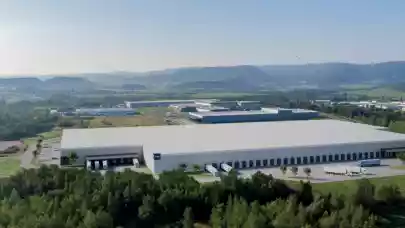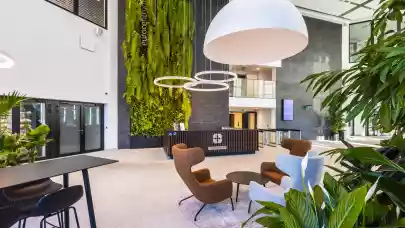
Tourism and the commercial real estate industry would both benefit from the existence of theme parks in CEE. Demand is real and exists, however, there are several challenges to address for both investors and developers. Property Forum asked Róbert Székely, Senior Hospitality and Leisure Advisor at Newmark VLK Hungary, to give an overview of the potential of such parks in our region.
Citizens of CEE have been visiting Western European theme parks in large numbers. Why don’t we see such parks in our region?
Unlike the Central and Eastern European (CEE) region, Western Europe has a long-standing history of tourism development, including popular theme and water theme parks. Countries such as France, Germany, the U.K., Denmark, Spain, and the Netherlands—to name a few—have been fostering investment in tourism infrastructure for decades. This allowed investors to establish and maintain numerous theme and themed water parks, renowned for their diverse attractions, unique attractions, innovative rides, and immersive experiences featuring globally recognized brands, characters, and franchises.
The CEE region hasn't experienced the same historical organic progression in tourism and leisure offerings, putting the region somewhat behind in these developments and this is why we don’t see such parks in our region. The few existing similar attractions are often in a much more modest form. As a result, the theme and amusement parks primarily attract local or regional interest. However, the driving force is present for CEE to facilitate the development of a quality large-scale theme park: the market size is substantial (100 Million+), and discretionary income is strong (this income currently is spent in Western European parks also paying the surcharge of travelling and accommodation).
Despite the existing demand, it will not be easy to develop in the CEE and surpass the decades of investment and the long native advancement of the Western European markets: e.g. only PortAventura in Spain boasts more than 5 kilometres of roller coasters, so you can imagine the immense resources required to replicate such a supply. Even knowing that some ride components in Western European parks are manufactured in CEE factories by CEE suppliers. There is one more aspect to consider: visitors from CEE countries also have the opportunity to immerse themselves in a different culture by visiting theme parks in Western Europe. A trip to Disneyland Paris, for example, allows them to experience Parisian architecture, gastronomy, and more which is an extra layer of attractive experience. In addition, these parks frequently host special events, seasonal festivals, and themed celebrations throughout the year so visitors from CEE countries might plan their trips around these events to add extra excitement and fun to their visit.
As an investor contemplates investing in a classic theme park in the CEE region, it's crucial to acknowledge that their Western counterparts are already addressing new development patterns. Traditionally, theme park development focused on balancing indoor and outdoor elements with the majority being outdoors. However, recent trends reveal shifting dynamics: firstly, there's a growing trend of multiple (new) generations seeking entertainment together, demanding diverse experiences.
This evolution in guest expectations might prompt adjustments in the traditional mix of indoor and outdoor attractions, potentially favouring more indoor experiences. Secondly, the impact of AI on theme park attractions remains uncertain, presenting opportunities for unseen or more innovative attractions in the future. Another significant aspect to consider is the uncertainty of changing weather patterns. With the weather becoming increasingly unpredictable, marked by storms and extreme heat, there is a potential decrease in the number of operating days for outdoor attractions. This shift in climate patterns is likely to lead to a greater focus on developing indoor entertainment options.

Róbert Székely
Senior Hospitality and Leisure Advisor
Newmark VLK Hungary
Momentum Leisure is going to develop a theme and water park at Europa Centralna retail centre in Poland. Does it mean that a standalone theme park is more risky than one at an existing retail destination?
My experience has shown that the success of a stand-alone theme park isn't necessarily riskier than one developed at a retail centre—however, it all comes down to what's planned for construction. Smaller amusement parks, drawing in day-use visitors with local or regional interests, can benefit greatly from being part of a retail centre. This setup allows them to work well with the existing infrastructure of the retail park, reducing overall development costs compared to starting from scratch.
Moreover, a smaller theme park can tap into the retail centre's marketing channels and promotional activities, reaching a broader audience. The retail centre likely has an established presence in the market, which can boost the park's reputation and visibility by association. Developing a theme and water park within an existing retail destination comes with many advantages and helps mitigate certain risks. However, despite its advantages, it's still crucial to conduct thorough market research, feasibility studies, and financial analyses to ensure the project's success. The park's uniqueness, pricing strategy, operational efficiency, customer experience, and management all play crucial roles in its success.
That said, a larger theme park drawing significant international visitors would be better suited for a standalone location. Larger parks often function as resorts, and retail parks aren't typically the destinations where visitors spend their trips or vacations. It's also worth noting that while a retail park can handle a few thousand visitors—albeit with some impact—when it comes to handling 2-3 million visitors, the area could become extremely overwhelmed.
A prime example of a successful standalone theme park operation is Europa Park in Rust, Germany. Despite its location in a relatively remote area, away from major transport crossroads, it manages to draw in approximately 5 million visitors annually. This makes it the second most visited theme park – together with Efteling - in Europe, following only Disneyland Paris. Most of the famous theme parks, - with a few exceptions like Tivoli Gardens -, are situated in relatively remote locations. There's a strategic reason behind this choice: it allows for easier expansion compared to more urban or structured environments. Typically, a theme park needs around 25 hectares of space to start. However, the nature of entertainment demands continuous renewal of attractions. Some parks achieve this by adding new elements, and expanding into neighbouring areas as needed.
How about adding a hotel element to a theme parks scheme like in the US or other big markets?
If the collection of amusement attractions draws international visitors to a theme park, then the answer is definitely yes. However, it's worth noting that in the European market, it's less common for people to visit a theme park to spend a full vacation of 7 or more days, as often seen in the US or Asia, the two largest theme park markets. The average visitation duration for parks with international visitors in Europe tends to be 1-3 days. Adding a hotel to a resort is a way to differentiate it, as it transforms the park into a resort destination in its own right. This becomes particularly appealing, especially for larger families.
However, in many cases, accommodations are developed by third parties and sometimes these hotels are located off-site. On-site hotels serve as tools to reduce seasonality, and some parks have also introduced MICE (Meetings, Incentives, Conferences, and Exhibitions) services, attracting corporate clients for so-called residential conferences and incentive groups.
What is the ideal location in Hungary, Slovakia or Romania to start such complex developments?
If the goal is to construct a large-scale theme park aimed at attracting international visitors, then the location becomes critically important: it needs to be situated where it can reach the maximum potential demand in visitors for the CEE region. Slovakia and the northern regions of Hungary e.g. could serve as good options for such developments, ideally positioned along major crossroads. These countries are located in the heart of the CEE region and could tap into a market of approximately 80-100 million people. When considering the Baltic and Balkan regions as well, this potential market could grow even larger.
However, the location of a park with lower, e.g. national importance also comes with other requirements. It should ideally be located possibly near the capital or major secondary cities, and easily accessible via major crossroads. Accessibility is crucial considering the current travel patterns in the region, where most visitors would likely arrive by car. Nevertheless, I would like to emphasize the importance of train accessibility as an excellent tool to ensure a more balanced visitation pattern in the CEE.
Over the last two decades, I've encountered several ideas for developing large theme parks in the CEE region, specifically in Hungary, Romania, and Poland. Unfortunately, none of these ideas ever materialized. I strongly believe that the region deserves a minimum of one strong theme park with an international reputation, however, with such a strong competitive supply in Europe, a developer would be in a very difficult situation to outpace the current Western European offer.
Managing theme parks needs special knowledge. Are there enough professionals to do this job in CEE?
Undoubtedly, despite its challenges, the theme park industry is poised for growth here, and this will result in a rising demand for professionals possessing specialized knowledge and skills to effectively manage and operate theme parks. The industry in CEE may not yet have as many experienced professionals as established markets like Western Europe. However, there are numerous professionals currently employed at major operating parks who originate from various CEE countries. These professionals may potentially consider to return to manage new developments in the region bringing home very valuable management know-how. They just need to be found and addressed properly.
A significant challenge lies in the availability of service and line associates as well as various attendants. This scarcity of employees is not unique to the theme park industry, as other sectors of tourism, such as hotels and restaurants, also struggle to secure an adequate workforce. The management of a theme park requires a considerable number of employees to operate smoothly. The revenue distribution in a park could typically consist of 50-70% from entry tickets, with the remaining portion coming from food and beverage (F&B) consumption and merchandise sales. This means that all the F&B outlets and retail shops within the park also need to be staffed, and finding and securing enough employees for these roles can be extremely challenging in today's market.
How about financing? Are banks keen on giving money or they are reluctant to do so?
It's challenging to provide a definitive answer, as there are few operating theme parks in our region and probably even fewer – if any - have been financed in recent years. Smaller-scale parks may find it easier to secure financing from banks. However, the development of a large-scale park entails considerable costs and risks, potentially making it a daunting prospect for bank financing. Some large Western European parks have faced financial difficulties in the past despite operating in more established markets and this also raises concerns regarding financing when considering such ventures, especially large ones.
The eagerness of a bank to finance such a development could increase with the presence of substantial state subsidies. However, financial risks extend beyond the initial investment. Parks must also navigate evolving demand patterns, such as the preferences of new generations for different types of entertainment. Climate change poses an additional risk, impacting the number of operational days for outdoor attractions. Moreover, parks will increasingly need to comply with ESG requirements in the future, adding another layer of complexity. Visitor expectations are also changing, with guests becoming less tolerant of long wait times for rides. Parks must address these factors to achieve their business goals moving forward. Additionally, attractions can become outdated over time, necessitating continuous investment (CAPEX) to maintain visitor interest. All these factors as well as the ongoing need for updates and improvements present a financial risk that both developers and financing parties must carefully consider.
How can these theme parks be attractive to private or institutional investors?
Indeed, a crucial factor could be the involvement of state subsidies or governmental partnerships, which might increase the interest of private investor entities. Such partnerships could be particularly effective if the development of a theme park is integrated into a specific development strategy for a region or a particular economic area. This could include initiatives to boost tourism, create employment opportunities, or promote local economic development within the region. When a theme park project aligns with broader regional or economic development goals, it often becomes more attractive to both private investors and potential funding sources.



